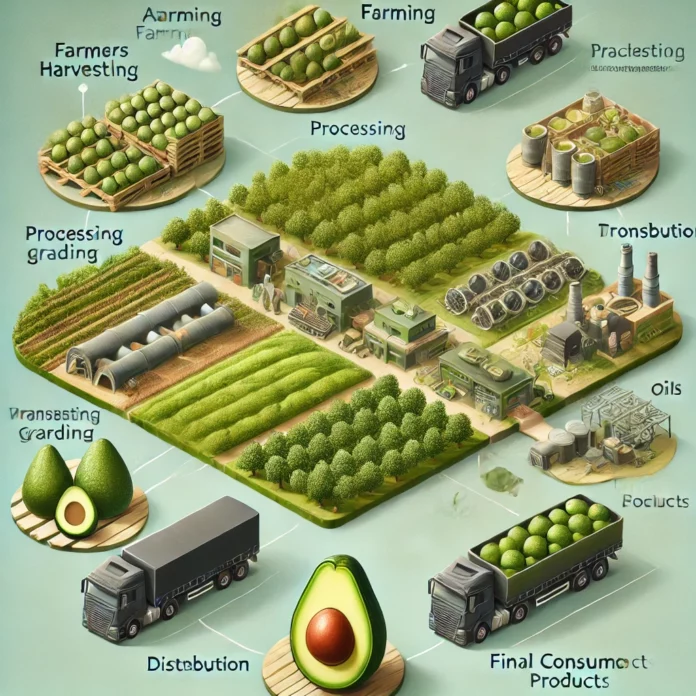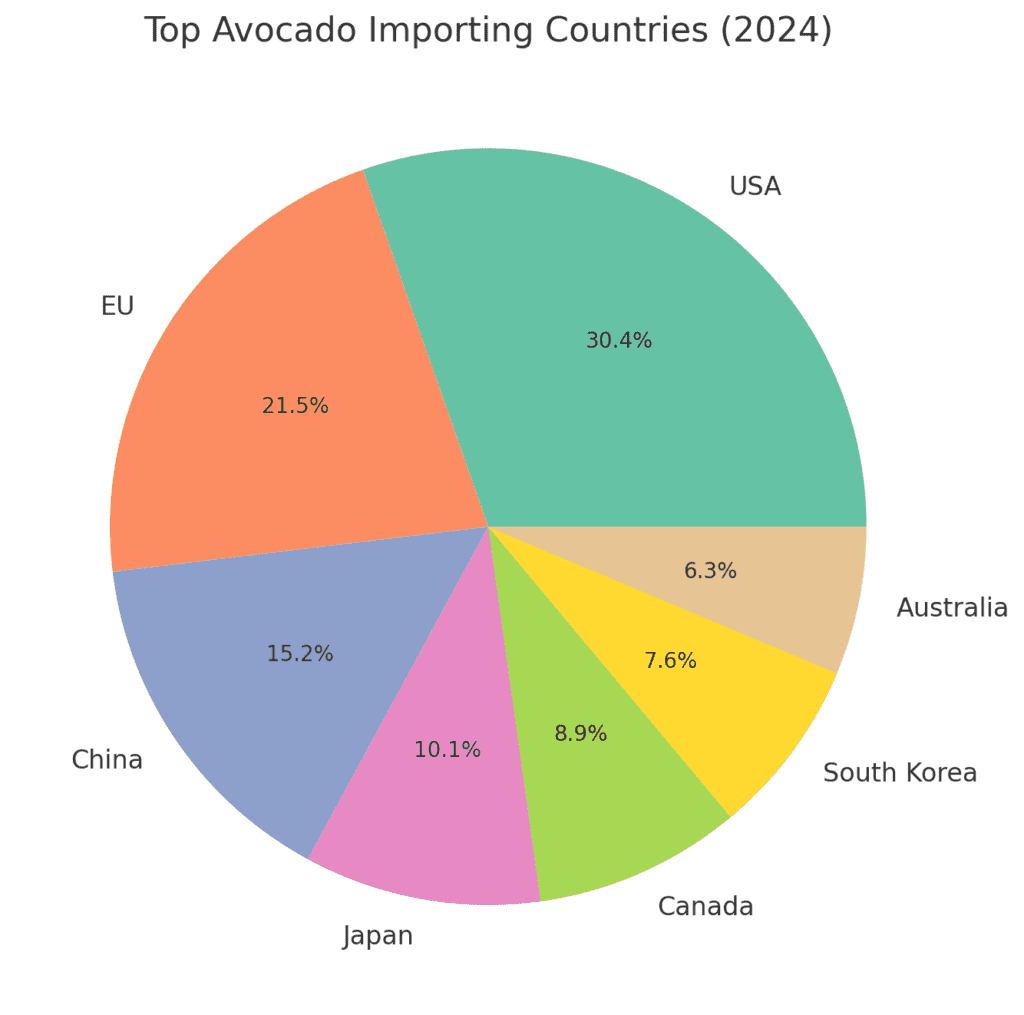
Introduction
The global avocado industry has witnessed unprecedented growth over the past two decades, driven by increasing consumer demand, health trends, and expanding global trade. Avocados have become a staple in diets worldwide, particularly in North America, Europe, and Asia, due to their rich nutritional profile, versatility, and perceived health benefits. However, the industry faces several challenges, including climate change, trade restrictions, sustainability concerns, and fluctuating market prices. This report provides a comprehensive analysis of the current state of the global avocado industry, covering production, trade dynamics, market trends, challenges, and future outlook.

Global Avocado Production
Leading Avocado-Producing Countries
The global avocado market is dominated by a few key producing countries, primarily located in Latin America and parts of Africa and Asia. The top avocado-producing countries include:
- Mexico – The world’s largest producer, accounting for nearly 30% of global avocado supply.
- Dominican Republic – A significant producer supplying mainly to Caribbean and North American markets.
- Peru – A leading exporter, especially to Europe and China.
- Colombia – A growing powerhouse in avocado production.
- Indonesia – A major producer within Southeast Asia.
- Kenya – Africa’s leading avocado exporter.
- United States – Limited production, primarily in California and Florida.
Production Trends
Avocado production has been expanding to new regions, particularly in South America and Africa, where favorable climates and lower labor costs provide competitive advantages. Countries such as Ethiopia, Tanzania, and Brazil are increasing production to meet global demand. Additionally, technological advancements in precision agriculture, irrigation systems, and pest control are improving yields and efficiency.
Global Avocado Trade & Market Dynamics
Exporting Countries
Mexico leads global avocado exports, with key destinations including the United States, Canada, Japan, and the European Union. Peru and Colombia have also expanded their export capacities, with strong trade ties to China, the EU, and the Middle East.
Importing Countries
The largest avocado-importing markets include:
- United States – The world’s top importer, with over 80% of its avocados coming from Mexico.
- European Union – Demand is rising, particularly in the UK, France, Germany, and Spain.
- China – A rapidly growing market for premium avocados.
- Japan & South Korea – Stable markets with consistent demand.
Trade Regulations & Barriers
The global avocado trade is influenced by stringent phytosanitary requirements, trade agreements, and tariff structures. Recent regulatory changes in China, the EU, and the US have affected supply chains, requiring producers to adhere to stricter food safety and sustainability standards.
Market Trends & Consumer Demand
Health & Wellness Trends
The global shift towards healthier eating has significantly boosted avocado consumption. The fruit is widely marketed for its high content of healthy monounsaturated fats, vitamins, and fiber, which align with the growing popularity of plant-based diets and functional foods.
Growth in Processed Avocado Products
Beyond fresh avocados, the demand for processed products such as guacamole, avocado oil, and avocado-based snacks is increasing. Avocado oil, in particular, is gaining traction in the health and beauty sectors due to its skin and hair benefits.
Rising Popularity in Emerging Markets
While North America and Europe remain dominant consumers, emerging markets such as China, India, and the Middle East are experiencing rapid growth in avocado demand. These markets present new opportunities for exporters but also require tailored marketing strategies and infrastructure development.
Challenges Facing the Avocado Industry
Climate Change & Environmental Concerns
Avocado production is highly sensitive to climate conditions, with droughts, excessive rainfall, and temperature fluctuations affecting yields. Additionally, the industry is under scrutiny for its water-intensive nature, particularly in drought-prone areas like California and Chile.
Supply Chain & Logistics Disruptions
Global supply chain issues, including rising transportation costs, port congestion, and labor shortages, have impacted avocado distribution. Maintaining cold-chain logistics is crucial for preserving quality and reducing waste during transport.
Sustainability & Ethical Concerns
The rapid expansion of avocado plantations has raised concerns over deforestation, biodiversity loss, and fair labor practices. Governments and industry stakeholders are working on sustainable farming initiatives, certification programs, and fair trade policies to address these issues.
Price Volatility
Avocado prices are highly volatile due to fluctuations in supply, weather conditions, and market demand. Seasonal price swings and unexpected disruptions, such as the COVID-19 pandemic or geopolitical tensions, can impact profitability for farmers and traders.
Future Outlook & Opportunities
Expansion into New Production Regions
To diversify supply and mitigate risks, avocado production is expanding into new regions such as Africa (Ethiopia, Rwanda) and Asia (Vietnam, India). Investment in agritech and research is enhancing productivity and reducing environmental impact.
Technological Advancements in Farming
Innovations in precision agriculture, AI-driven monitoring systems, and blockchain for supply chain transparency are transforming the industry. These advancements will improve yields, reduce waste, and enhance traceability.
Growing Focus on Sustainability
Sustainability initiatives, including water-efficient irrigation, organic farming, and reforestation programs, are gaining traction. Consumers are increasingly demanding ethically sourced avocados, pushing companies to adopt responsible farming practices.
Increasing Market Penetration in Asia & Middle East
The potential for growth in China, India, and the Middle East remains immense. Market education, promotional campaigns, and improved distribution networks will play a vital role in expanding avocado consumption in these regions.
Diversification into Value-Added Products
The demand for avocado-based products such as oils, spreads, and functional foods is expected to rise. Companies investing in product innovation and branding will benefit from the expanding health-conscious consumer base.

Conclusion
The global avocado industry is at a crucial juncture, balancing growing consumer demand with sustainability challenges and market fluctuations. As new regions enter production, technology advances, and sustainability becomes a priority, the industry is set for continued evolution. Stakeholders must navigate regulatory landscapes, trade barriers, and environmental concerns while capitalizing on expanding markets and emerging opportunities. The future of the avocado industry will be shaped by its ability to adapt to changing consumer preferences, climate realities, and technological advancements, ensuring long-term growth and resilience in the global market.



